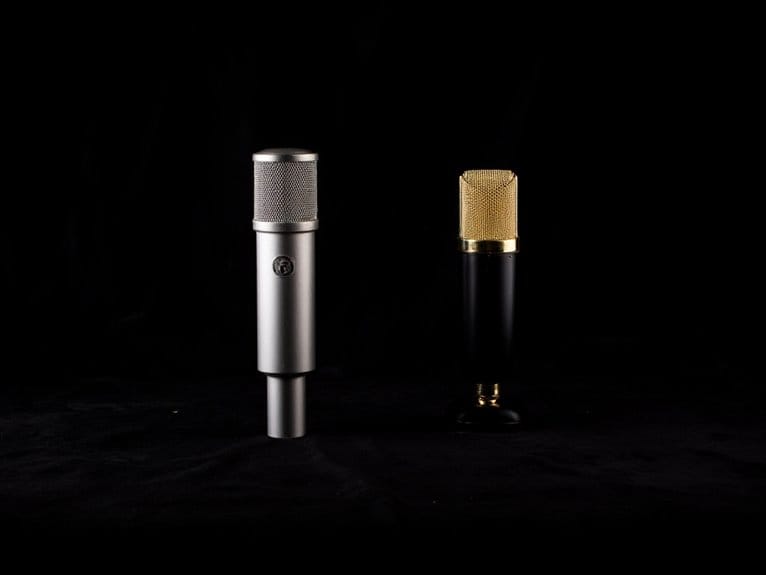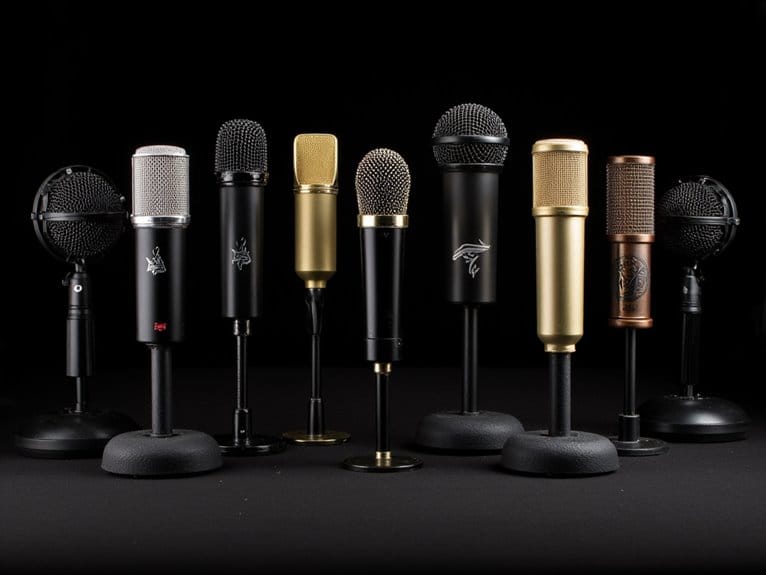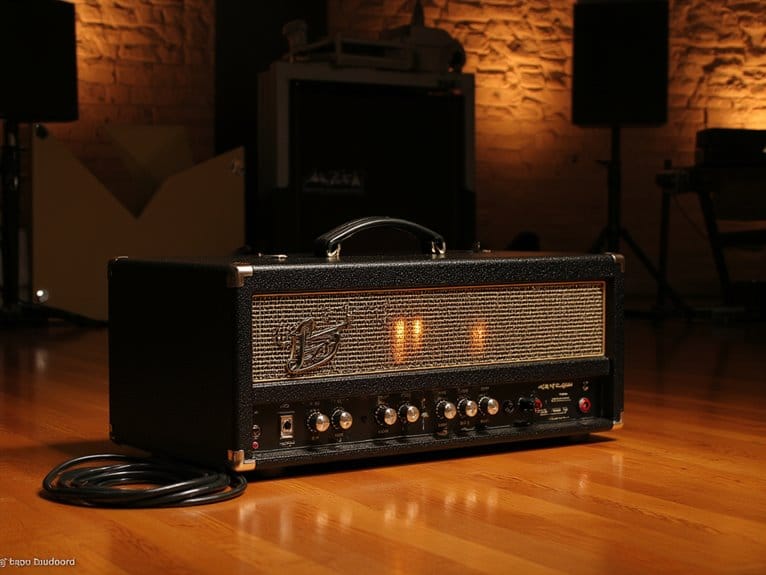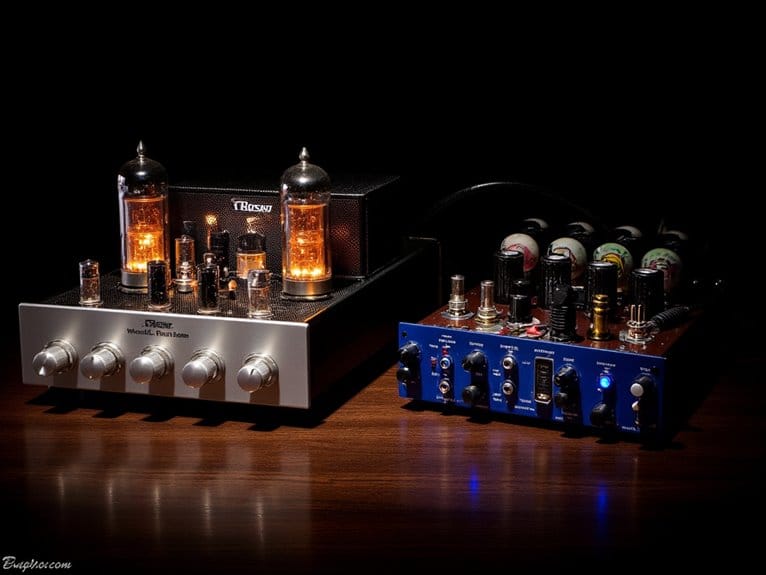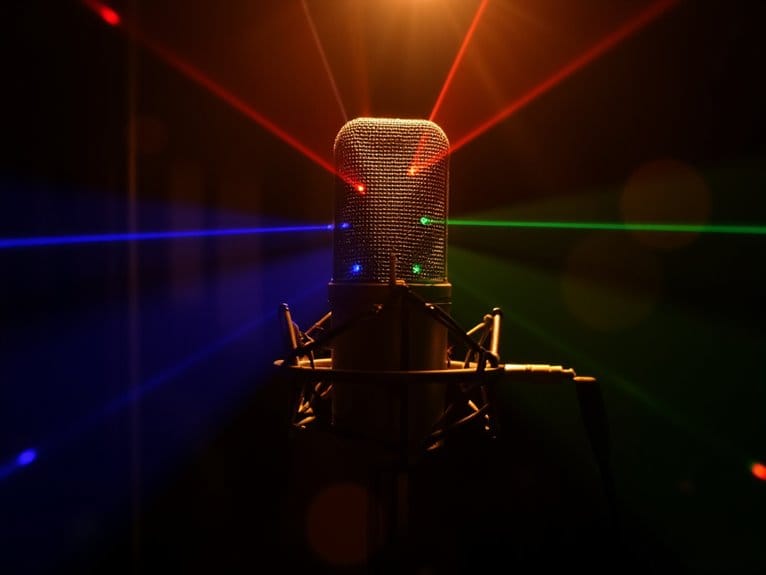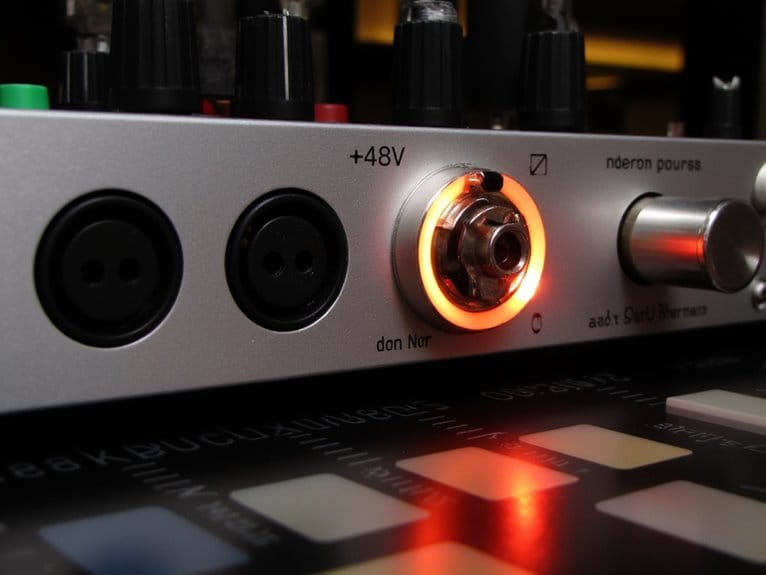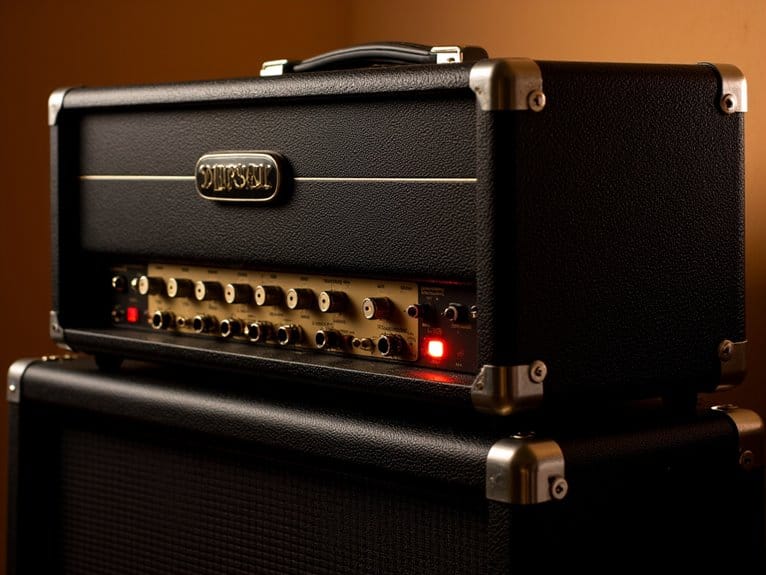Dynamic Vs Condenser Microphones: Complete Comparison
You’ll find that dynamic microphones use electromagnetic induction and don’t need external power, making them perfect for live performances and high-volume situations, while condenser mics rely on variable capacitance with +48V phantom power, offering superior sensitivity (8-32 mV/Pa versus 1-4 mV/Pa) and wider frequency response (20Hz-20kHz) for studio work. Dynamic mics excel in durability and noise rejection, whereas condensers capture intricate details but require careful handling—and there’s much more to take into account when choosing between them.
We are supported by our audience. When you purchase through links on our site, we may earn an affiliate commission, at no extra cost for you. Learn more.
Notable Insights
- Dynamic microphones use electromagnetic induction and require no power, while condenser microphones use variable capacitance and need phantom power.
- Condenser microphones offer higher sensitivity (8-32 mV/Pa) and wider frequency response (20Hz-20kHz) compared to dynamic microphones (1-4 mV/Pa, 50Hz-15kHz).
- Dynamic microphones excel in live performances and high-noise environments, while condenser microphones are preferred for detailed studio recordings.
- Dynamic microphones are more durable and require minimal maintenance, whereas condenser microphones are fragile and need careful handling.
- Dynamic microphones have lower initial costs and maintenance expenses compared to condenser microphones which require additional phantom power equipment.
Understanding the Core Technology Behind Each Microphone Type
When you’re choosing between dynamic and condenser microphones, understanding their fundamental operating principles makes all the difference in selecting the right tool for your specific recording needs.
Dynamic microphones rely on electromagnetic induction, where sound wave dynamics cause a coil attached to the diaphragm to move within a magnetic field, generating electrical current without requiring external power.
Condenser microphones operate through variable capacitance, using microphone construction techniques that position two plates—a backplate and diaphragm—where sound waves alter the distance between them, changing capacitance and voltage output.
This fundamental difference means condenser mics need phantom power for operation, while dynamic mics produce signal independently, making each type suited for distinctly different recording environments and applications. Dynamic microphones excel at handling high sound pressure levels effectively, making them particularly valuable for recording loud instruments and amplified sources.
Dynamic microphones function inversely to speakers, converting sound waves into electrical energy rather than converting electrical energy into sound.
Dynamic microphones generally operate well in various temperatures and do not require regular maintenance, contributing to their reputation for durability and reliability in professional settings.
Both microphone types benefit from proper cardioid polar patterns that capture voice while rejecting unwanted background noise during recording sessions.
Sensitivity and Signal Capture Capabilities
When you’re comparing dynamic and condenser microphones, you’ll quickly notice that their sensitivity levels create dramatically different recording experiences, with dynamics requiring more input gain to capture the same volume levels that condensers pick up effortlessly.
I’ve found that condenser microphones excel at capturing intricate signal details, from the subtle breath sounds in vocal performances to the delicate overtones of acoustic instruments, thanks to their inherently higher sensitivity to sound pressure variations. Professional condenser microphones typically maintain self-noise ratings between 4-20 dB for optimal recording quality.
Dynamic microphones utilize electromagnetic induction with a diaphragm attached to a coil of wire, which contributes to their lower sensitivity but also makes them more resistant to distortion from high sound pressure levels. Both microphone types can deliver professional results when paired with quality components that achieve a 70+ dB signal-to-noise ratio for optimal performance. Condenser microphones require phantom power to operate their internal electronics, which enables their superior sensitivity compared to self-powered dynamic microphones.
Your choice between these technologies ultimately depends on whether you prioritize the robust, focused capture of dynamic mics or the nuanced, thorough signal reproduction that condensers deliver.
Dynamic Microphone Sensitivity Levels
Understanding dynamic microphone sensitivity becomes essential when you’re evaluating how these workhorses capture sound, and honestly, the numbers can be a bit underwhelming at first glance.
Dynamic mics typically deliver 1 to 4 mV/Pa sensitivity, which translates to -60 to -48 dB re 1V/Pa, making them considerably less sensitive than their condenser counterparts that reach 8 to 32 mV/Pa.
However, this lower sensitivity actually creates significant dynamic microphone advantages in professional settings, allowing you to handle extremely high SPLs without distortion while maintaining excellent headroom. Moving coil dynamic mics can reach sensitivities of 3-4 mV, representing the higher end of the dynamic microphone sensitivity spectrum.
The reduced sensitivity makes these mics perfect for dynamic microphone applications like live vocals, guitar amps, and drums, where you need robust performance without the fragility that comes with higher-sensitivity designs. Dynamic microphones require higher preamplifier gain compared to more sensitive microphones to compensate for their lower output levels.
Condenser Signal Detail Capture
While dynamic mics excel through their rugged simplicity, condenser microphones take a completely different approach to sound capture, prioritizing sensitivity and detail above all else.
You’ll find that condensers can achieve sensitivity levels as high as -18 dBV with integrated preamps, compared to dynamic mics’ -54 to -52 dBV range. This enhanced sensitivity translates into remarkable signal detail capture, allowing you to hear subtle vocal nuances, acoustic instrument overtones, and room ambience that dynamic mics simply can’t reproduce.
However, this sensitivity demands careful consideration of studio acoustics and precise microphone placement, as condensers will pick up everything in your recording environment. The condenser’s design utilizes a capacitor mechanism where sound waves cause one plate to vibrate against a fixed plate, creating the electrical signals that capture these intricate details.
Their wide frequency response and excellent transient response make them ideal for capturing the true timbre of your sound sources. Professional condensers typically maintain self-noise levels between 25-30 dB, which is essential for achieving clean recordings in studio environments.
Frequency Response and Audio Range Performance
When you’re comparing dynamic and condenser microphones, you’ll quickly notice that frequency response represents one of the most significant performance differences between these two technologies.
I’ve found that condenser mics typically capture a much wider frequency range, spanning from 20 Hz to 20,000 Hz, while dynamic microphones generally operate within a more limited 50 Hz to 15,000 Hz spectrum.
This directly impacts their ability to reproduce the full breadth of audio detail. The reduced sensitivity of dynamic microphones means they might struggle with capturing high-frequency sounds that condenser mics handle with ease.
For classical guitar recording applications, this wide frequency response is particularly critical since the ideal range of 20 Hz to 20 kHz captures both the resonant lows and harmonic overtones that define the instrument’s full tonal spectrum.
Since the human vocal range of interest typically falls between 80Hz and 12kHz, understanding this frequency spectrum is crucial for selecting the right microphone for vocal applications.
Condenser microphones capture subtle vocal nuances, making them optimal for studio recordings and serious content creators who require high fidelity and detail.
Your choice between wide frequency capture range and transient response accuracy will ultimately determine whether you achieve studio-quality recordings with every subtle nuance preserved, or robust, focused sound that cuts through challenging environments.
Wide Frequency Capture Range
Since frequency response directly determines how much of the sonic spectrum your microphone can actually capture, I’d argue it’s one of the most critical factors separating dynamic and condenser mics in real-world performance.
Condenser microphones offer a remarkably wide frequency capture range spanning 20 Hz to 20,000 Hz, fundamentally covering the entire human hearing spectrum, while dynamic mics typically max out around 50 Hz to 15,000 Hz.
This difference notably impacts audio fidelity in ways you’ll immediately notice:
- Low-end capture – Condensers grab those rumbling bass frequencies and subtle room tones that dynamics simply miss.
- High-frequency detail – Breath sounds, cymbal shimmer, and vocal clarity shine through condenser recordings.
- Overall sonic completeness – You’ll hear a fuller, more accurate representation of your source material.
Transient Response Accuracy
The lightning-fast crack of a snare drum, the sharp attack of a piano key, or the crisp consonants in vocal delivery—these transient moments contain the sonic DNA that separates professional recordings from muddy, lifeless audio. This transient response comparison reveals why your microphone choice dramatically affects recording quality.
| Microphone Type | Rise Time | Detail Capture | Best Applications |
|---|---|---|---|
| Dynamic | Slower | Less precise | Live vocals, drums |
| Condenser | Ultra-fast | Highly detailed | Studio instruments |
| Dynamic | Robust sounds | Missed nuances | High SPL environments |
| Condenser | Sensitive capture | Sharp attacks | Vital listening |
Understanding transient accuracy importance becomes essential when you’re capturing instruments with quick attacks. Condensers excel at reproducing those millisecond details that give recordings their professional edge, while dynamics sacrifice some precision for durability.
Power Requirements and Phantom Power Dependencies
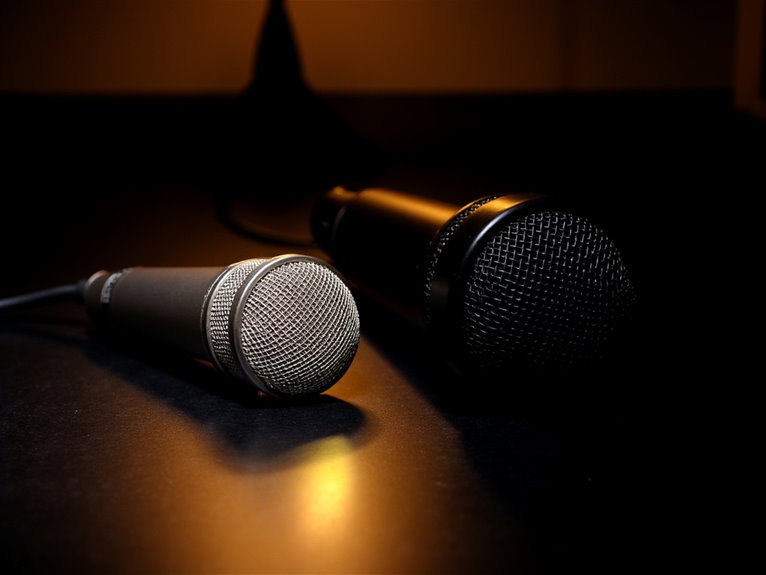
Understanding power requirements represents one of the most fundamental differences between dynamic and condenser microphones, and it’s something I’ve seen trip up countless audio enthusiasts who assume all mics work the same way.
Dynamic mics operate through passive moving coil mechanisms, converting acoustic energy into electrical signals without needing external power, while condensers require +48V phantom power to polarize their diaphragms and power internal amplifier circuitry.
Dynamic microphones work independently through electromagnetic induction, while condensers depend entirely on phantom power to function properly.
Here’s what you need to know about phantom power applications:
- Dynamic mics are plug-and-play devices that work immediately without power dependencies.
- Condenser mics can’t function without phantom power from your audio interface or mixer.
- Dynamic mic benefits include lower operational complexity and suitability for field recording situations.
Modern USB microphones offer convenient alternatives by drawing power directly from your computer, eliminating the need for separate phantom power sources while maintaining professional audio quality.
Durability and Build Quality for Different Environments
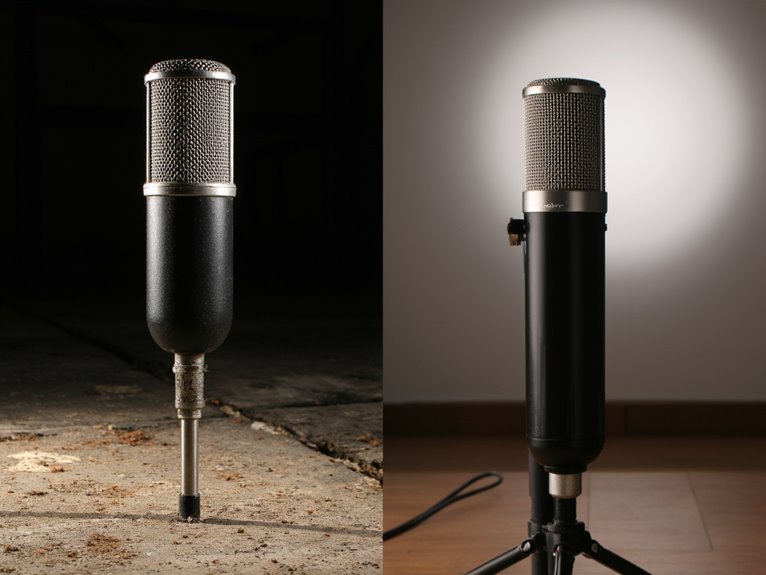
When you’re investing in microphones for different recording scenarios, durability becomes a make-or-break factor that I’ve learned to prioritize after watching countless mics suffer unnecessary damage in various environments.
Dynamic microphones excel in microphone durability through their moving coil mechanism, which resists physical shock, drops, and rough handling that would destroy delicate condensers. Their rugged construction makes them perfect for live performances, touring, and outdoor recordings where environmental variables constantly challenge equipment integrity. The dynamic cardioid design of these microphones also helps focus on front-facing sound sources while rejecting unwanted ambient noise in challenging acoustic environments.
Condenser microphones, while offering superior sensitivity, sacrifice durability for performance through their thin diaphragms and intricate internal electronics. Their environment suitability remains limited to controlled studio settings where temperature, humidity, and handling stay consistent.
I’ve found that condensers require careful protection and phantom power dependency, making them less practical for field work where dynamic mics consistently outperform them. Robust construction with break-resistant features proves essential for microphones used in touring situations, where heavyweight designs often indicate superior durability and long-term reliability.
Choosing the Right Microphone for Your Specific Needs
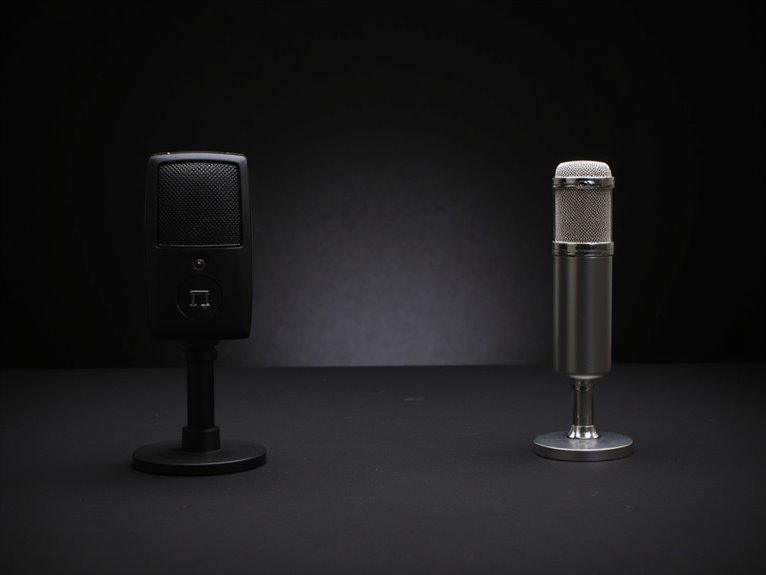
How do you determine which microphone type will serve your specific recording needs when both dynamics and condensers offer distinct advantages that can make or break your audio quality? I’ve learned that microphone selection factors depend heavily on your environment, sound sources, and technical requirements, which directly influence your application scenarios.
| Environment | Dynamic Choice | Condenser Choice |
|---|---|---|
| Untreated Room | Podcasting, vocals | Avoid due to noise pickup |
| Studio Setting | Drums, guitar amps | Vocals, acoustic instruments |
| Live Performance | All applications | Limited use cases |
Your recording environment matters most—if you’re working in untreated spaces, dynamics excel at rejecting background noise, while condensers demand sound-treated rooms to showcase their superior sensitivity and frequency response without capturing unwanted ambient sounds.
Frequently Asked Questions
Can I Use a Condenser Microphone Without an Audio Interface?
You can absolutely use a condenser microphone without an audio interface, though you’ll need condenser microphone alternatives like USB preamps or powered mixers that supply phantom power.
Portable recording solutions include devices like the MXL Mic Mate Pro, which converts XLR to USB while providing necessary power.
I’ve found that battery-powered phantom supplies work well too, enabling direct connection to amplifiers or recording devices with proper signal boosting.
Do Dynamic Microphones Work Better in Humid or Cold Weather Conditions?
You’ll find that dynamic microphones absolutely excel in challenging weather conditions, particularly when dealing with humidity effects and cold weather scenarios.
Their robust coil-and-magnet design resists moisture damage far better than sensitive condensers, which I’ve learned can malfunction when exposed to sweat or dampness.
In cold weather, dynamics maintain stable performance since they don’t rely on delicate electronics, making them your reliable choice for outdoor recording.
Which Microphone Type Is Better for Recording Instruments Like Violin or Piano?
For violin recording and piano acoustics, you’ll want condenser microphones every time.
I’ve found that condensers capture those delicate string harmonics and subtle piano overtones that dynamics simply miss, thanks to their superior sensitivity and wider frequency response from 20 Hz to 20 kHz.
While dynamics are tougher, they can’t match condensers’ detail for acoustic instruments in controlled studio environments.
Can I Damage a Condenser Microphone by Speaking Too Close to It?
Speaking too close to your condenser microphone won’t physically damage it, though you’ll encounter microphone proximity effects that boost bass frequencies, making vocals sound muddy.
I’ve found that extreme closeness can cause vocal sibilance issues, where harsh “s” and “t” sounds become unpleasantly prominent due to the mic’s sensitivity.
Maintain 6-12 inches distance for ideal sound quality without risking damage.
Do Professional Podcasters Prefer Dynamic or Condenser Microphones for Home Studios?
Professional podcasting preferences lean heavily toward dynamic microphones for home studios, with the Shure SM7B representing the gold standard in microphone specifications.
You’ll find dynamics reject background noise better in untreated rooms, while condensers require acoustic treatment to shine.
I’ve observed most pros choose dynamics for their durability, simplified setup without phantom power, and natural vocal warmth that translates well across listening devices.
On a final note
You’ve now got the essential knowledge to make an informed microphone decision, whether you’re tracking vocals in a home studio, capturing live performances on stage, or podcasting from your bedroom. Dynamic mics excel in rugged, loud environments without needing phantom power, while condensers deliver superior sensitivity and detail for controlled recording situations. Consider your specific use case, budget constraints, and recording environment when choosing between these two fundamental microphone technologies.

